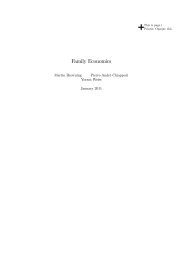Bounded Rationality in Industrial Organization
Bounded Rationality in Industrial Organization
Bounded Rationality in Industrial Organization
Create successful ePaper yourself
Turn your PDF publications into a flip-book with our unique Google optimized e-Paper software.
to assume that they fully understand the social processes by which some products achieve<br />
popularity. Ellison and Fudenberg (1993) builds on the Smallwood-Conlisk approach to<br />
explore whether dispersed <strong>in</strong>formation about product quality will be aggregated at the<br />
population level and come to be reflected <strong>in</strong> adoption decisions.<br />
We identify two mechanisms by which such “social learn<strong>in</strong>g” can occur. In one <strong>in</strong>formation<br />
is aggregated via agents pay<strong>in</strong>g attention to popularity. In the other it is aggregated<br />
by geography. In both models, there are two technologies f and g. The payoffs are random<br />
variables related by u g t − uf t = θ + ɛ t with ɛ t uniformly distributed on [−σ, σ]. <strong>Bounded</strong>ly<br />
rational players observe u g t − uf t , but don’t know the full history of payoff realizations. The<br />
popularity model looks at a homogeneous population <strong>in</strong> which there is <strong>in</strong>ertia and <strong>in</strong> which<br />
players who do switch are more likely to use more popular actions: players choose g if<br />
u g t − uf t > k(m t(f) − m t (g)), where k is a positive constant and m t (f) is the market share<br />
of technology f at time t. In this model, we show that with no popularity weights (k = 0)<br />
both technologies get positive shares <strong>in</strong> the long run. With k > σ there can be herd<strong>in</strong>g on<br />
an <strong>in</strong>ferior technology. With k = σ full learn<strong>in</strong>g occurs <strong>in</strong> the long run and all consumers<br />
eventually adopt the superior technology.<br />
In the geographic model, players are arrayed on a l<strong>in</strong>e (which could be a physical<br />
location or a position <strong>in</strong> some social network or taste space). There is no longer a s<strong>in</strong>gle<br />
best technology – which technology is superior depends on the location. Players observe the<br />
technology choices of those <strong>in</strong> a neighborhood around them, and also observe the average<br />
payoff of any technology used <strong>in</strong> their neighborhood. In this model, we show that social<br />
learn<strong>in</strong>g occurs via a geographic mechanism: the divid<strong>in</strong>g po<strong>in</strong>t between the f-adopters<br />
and the g-adopters shifts over time and a law-of-large-numbers mechanism keeps it close to<br />
the optimum when the observation neighborhood is small. There is a tradeoff between the<br />
speed of adoption and its long-term efficiency.<br />
Ellison and Fudenberg (1995) consider a model closely related to the nonspatial model<br />
described above. There are two primary differences: there is a random idiosyncratic component<br />
to the payoff each agent receives <strong>in</strong> each period; and we consider rules-of-thumb<br />
<strong>in</strong> which an agent asks k randomly selected members of the population about the payoffs<br />
16













